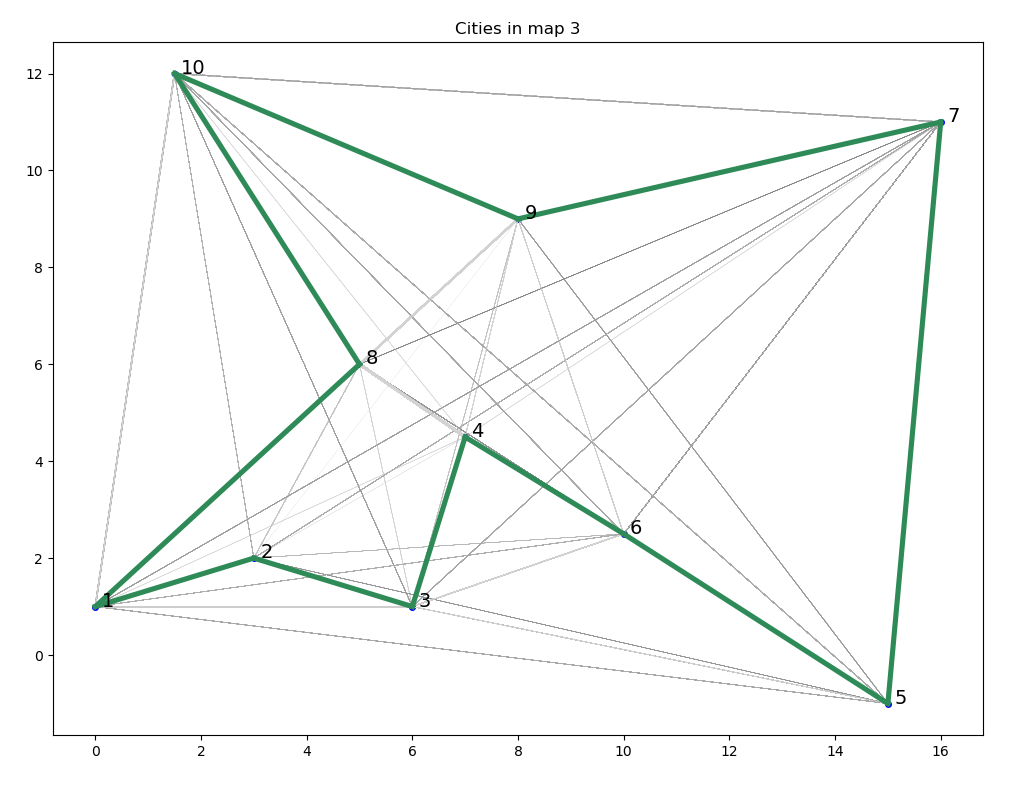"""
Implementation of Ant Colony System for the travelling salesman problem.
We are given a map containing 10 cities on 2d plane. In order to find the
shortest path that goes through all of them we utilize simulated ants,
depositing pheromones in greater amount on shorter paths and then choosing
the paths with more pheromone on them. The ants also have a memory of the
visited cities, otherwise it's just a stochastic process.
"""
import math
import random as rnd
import pandas as pd
import matplotlib.pyplot as plt
class AntColonySystem:
"""Class handling ants and map creation, iterations and more."""
def __init__(self, ants_count, alpha=1, beta=5, rho=0.5, tau_0=0.1):
"""
Create a simulation object by specifying needed parameters.
m - the number of ants
alpha, beta - decision coefficients (pheromone and distance)
rho - pheromone evaporation coefficient
tau_0 - initial pheromone amount
"""
self.ants_count = ants_count
self.alpha = alpha
self.beta = beta
self.rho = rho
self.tau_0 = tau_0
def open_map(self, map_id):
"""Use the provided data file to import the coordinates of cities."""
self.map_id = map_id
cities = open(f'data/AS_map_{map_id}.txt')
for line in cities:
line = line.strip()
if line[0] == 'x':
self.x = list(map(float, line[5:-2].split()))
if line[0] == 'y':
self.y = list(map(float, line[5:-2].split()))
# Check validity of coordinates in the file
if len(self.x) != len(self.y):
raise SystemExit("Cities coordinates invalid")
self.N = len(self.x)
return self.N
def prepare_distance_table(self):
"""Calculate the euclidean distance between each two cities."""
self.d = pd.DataFrame(data=self.tau_0, index=range(1, self.N+1),
columns=range(1, self.N+1))
for city_1 in self.d:
self.d[city_1] = [self.distance(city_1, city_2)
for city_2 in self.d.index]
def prepare_pheromone_table(self):
"""Calculate the amount of pheromone between each two cities."""
self.tau = pd.DataFrame(data=self.tau_0, index=range(1, self.N+1),
columns=range(1, self.N+1))
for i in self.tau.index:
self.tau.loc[i, i] = 0
def set_hometowns(self):
"""Create a list of fixed starting points for each ant."""
self.hometowns = [rnd.randint(1, self.N)
for _ in range(ant_colony.ants_count)]
def spawn_ants(self):
"""Create a table of ants, with a record of visited cities."""
self.ants = pd.DataFrame(data=False, index=range(self.ants_count),
columns=range(1, self.N+1))
self.ants['Current'] = self.hometowns
self.ants['TourLength'] = 0.0
for ant in self.ants.index:
self.ants.loc[ant, self.ants.loc[ant, 'Current']] = True
def draw_map(self):
"""Draw a map of the cities."""
self.fig, self.ax = plt.subplots()
self.fig.set_size_inches(12, 9)
self.ax.plot(self.x, self.y, 'bo', ms=4)
self.ax.set_title(f'Cities in map {self.map_id}')
for i in range(0, self.N):
self.ax.annotate(i+1, (self.x[i]+0.12, self.y[i]), fontsize=14)
def ants_tour_complete(self):
"""Return whether all ants visited all the cities."""
return (self.ants.xs(range(1, self.N+1), axis=1).all()).all()
def calculate_decision_table(self):
"""Calculate a decision table with probability of taking each path."""
# Probability proportional to pheromone amount over distance
a_naive = (self.tau**self.alpha/self.d**self.beta).fillna(0)
# Dividing probabilities by the sum of eligible neighbours
self.a = pd.DataFrame(index=self.ants.index, columns=a_naive.columns)
for ant in self.ants.index:
current = self.ants.loc[ant, 'Current']
neighbourhood = sum(a_naive[current]
* ~self.ants.loc[ant][:self.N])
self.a.loc[ant] = ((a_naive[current] / neighbourhood)
* ~self.ants.loc[ant][:self.N])
def choose_next_cities(self):
"""Return a series of next moves for each ant."""
next_cities = pd.Series(index=self.ants.index, data=0)
for ant in self.a.index:
preferred = pd.to_numeric(self.a.loc[ant]).fillna(0)
its_my_goddamn_choice = rnd.random()
while(len(preferred) > 0):
best_city = preferred.idxmax()
if (its_my_goddamn_choice <= preferred[best_city]):
next_cities.loc[ant] = best_city
break
else:
its_my_goddamn_choice -= preferred[best_city]
preferred.drop(best_city, inplace=True)
return next_cities
def finish_in_hometowns(self):
"""Add a final path to the tour, from current city to hometown."""
for ant in self.ants.index:
current = self.ants.loc[ant, 'Current']
self.ants.loc[ant, 'TourLength'] += self.distance(
current, self.hometowns[ant])
self.draw_path(current, self.hometowns[ant], 'grey',
self.tau.at[current, self.hometowns[ant]])
self.ants.loc[ant, 'Current'] = self.hometowns[ant]
def update_pheromones(self, tours, elite_ants_count=4):
"""Evaporate some of the existing pheromones and deposit new."""
# Evaporte some of the pheromone
self.tau *= (1 - self.rho)
# Store best N ants in a dictionary with their tour lengths
elite_ants = {ant: self.ants.loc[ant, 'TourLength'] for ant in tours}
elite_ants = dict(sorted(elite_ants.items(), key=lambda ant: ant[1]))
elite_ants = list(elite_ants.items())[:elite_ants_count]
# Add pheronome only on the elite ants paths
for ant, best_length in elite_ants:
for city in range(self.N):
self.tau.at[tours[ant][city], tours[ant][(city+1) % self.N]] \
+= 1/best_length
self.tau.at[tours[ant][(city+1) % self.N], tours[ant][city]] \
+= 1/best_length
def draw_shortest_path(self, shortest_path):
"""Draw in green the shortest path from all iterations."""
for city in range(self.N):
self.draw_path(shortest_path[city],
shortest_path[(city+1) % self.N],
'seagreen', 0.6)
def distance(self, city_1, city_2):
"""Calculate distance between two cities based on their id numbers."""
x_1 = self.x[city_1 - 1]
x_2 = self.x[city_2 - 1]
y_1 = self.y[city_1 - 1]
y_2 = self.y[city_2 - 1]
return math.sqrt(pow(x_1 - x_2, 2) + pow(y_1 - y_2, 2))
def draw_path(self, city_1, city_2, line_color, pheromone):
"""Draw a line between cities, thickness based on pheromone amount."""
x_1 = self.x[city_1 - 1]
x_2 = self.x[city_2 - 1]
y_1 = self.y[city_1 - 1]
y_2 = self.y[city_2 - 1]
self.ax.plot([x_1, x_2], [y_1, y_2],
color=line_color, linewidth=(10*pheromone**2+0.1))
if __name__ == "__main__":
# Create an ant colony and prepare the environment
ant_colony = AntColonySystem(20, alpha=0.5)
ant_colony.open_map(3)
ant_colony.prepare_distance_table()
ant_colony.prepare_pheromone_table()
ant_colony.set_hometowns()
ant_colony.draw_map()
# Number of iterations (repeated tour taking)
TOTAL_ITERATIONS = 50
# Set the shortest path length holder variable
shortest_path_length = sum(ant_colony.d.unstack())
# Drop all ants on the map for the given number of times
for iteration in range(TOTAL_ITERATIONS):
# Create an internal table of ants with memory of visited citites
ant_colony.spawn_ants()
# Set up a dictionary of cities visited by each ant in order
tours = {ant: [ant_colony.ants.loc[ant, 'Current']]
for ant in ant_colony.ants.index}
# Until there is at least one unvisited city by at least by one ant
while (~ant_colony.ants_tour_complete()):
# Prepare a decision table with probabilities of chosing cities
ant_colony.calculate_decision_table()
# Selecting next cities to travel to
next_cities = ant_colony.choose_next_cities()
# Travelling to the chosen city
for ant in ant_colony.ants.index:
current = ant_colony.ants.loc[ant, 'Current']
# Calculate distanace, add to tour length
ant_colony.ants.loc[ant, 'TourLength'] \
+= ant_colony.distance(current, next_cities[ant])
# Plot the travel from current city to the next one on a map
ant_colony.draw_path(current, next_cities[ant], 'lightgrey',
ant_colony.tau.at[current,
next_cities[ant]])
# Set new city as the current city, add to tour
ant_colony.ants.loc[ant, 'Current'] = next_cities[ant]
tours[ant].append(next_cities[ant])
# Update visited cities
ant_colony.ants.loc[ant,
ant_colony.ants.loc[ant, 'Current']] = True
# After the complete tour go back to respective hometowns
ant_colony.finish_in_hometowns()
# Evaporate some and deposit new pheromones
ant_colony.update_pheromones(tours, elite_ants_count=6)
# Evaluate shortest travel distance
for ant in tours:
if ant_colony.ants.loc[ant, 'TourLength'] <= \
shortest_path_length:
shortest_path_length = ant_colony.ants.loc[ant, 'TourLength']
shortest_path = tours[ant]
# Print the shortest distance in this iteration
iter_best = min(ant_colony.ants['TourLength'])
print(f'Shortest path length in iteration {iteration+1}: {iter_best}')
# Draw the shortest path on the map
ant_colony.draw_shortest_path(shortest_path)
# Output the final result
print(f'Shortest path: {shortest_path}\nLength: {shortest_path_length}\n')
plt.show()



